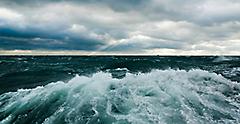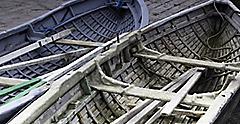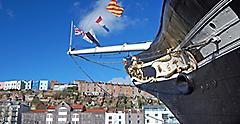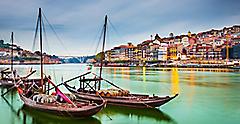The transatlantic route is a significant event for modern America, as this momentous journey had a massive impact on the current people and culture. The trade triangle that it created still impacts the culture and economy of Europe and Africa today.

Who Made The First Transatlantic Crossing?
Humanity is a whopping 200,000 years old, so you can imagine why historians disagree on what is truly considered the first crossing. The explorer Christopher Columbus is often credited as the one who made the first transatlantic journey in 1492, discovering and settling America in the process. And while it was a pretty big deal when he landed on the continent, Columbus' boots weren't the first to hit the ground. It's likely that hundreds came before him.

But Columbus' crossing is still important to transatlantic history. His crossing sparked the imagination of millions of European traders and triggered massive colonization events. It ultimately thrust Spain into the spotlight as the world's first global superpower. Back in the 16th century, the Americas were unknown to Europe. The wheels of fate were set in motion when Columbus had reasoned that, since the world was round, sailing to the west would inevitably take him to the spice-rich lands of India. He was correct in theory but underestimated the size of the world by an entire continent. That's why when Columbus first saw the Native Americans, he thought he'd found India and unfortunately called them "Indians."
Historians (mostly) agree that the Vikings made the first transatlantic crossing in the 10th century — totally by accident. The explorer Leif Erikson was one of the first Vikings to land on North American shores after being blown off-course on a routine trip to Norway. In true Viking fashion, Erikson claimed the lush area by naming it "Vinland" due to the many grapevines his party encountered. Shortly after arriving, he set sail back to his homeland, picked up some shipwrecked Norsemen on the way, and never returned. Those who heard his tale sailed to Vinland, repeating Erikson's fateful journey in search of rich new lands. They built a small settlement and traded with the native people they found there. After some tensions and skirmishes, the Norsemen abandoned the settlement entirely. And America was cut off from the rest of the world until the Spanish discovery.
While Norway has the strongest claim for the first transatlantic crossing by ship, some fringe theories say the crossing was made by humans hundreds or even thousands of years earlier. In the 6th century, the Irish monk St. Brendan supposedly sailed from Ireland to North America. His ship was a small, crude vessel called a "currach" built of wood and animal skin. Brendan's adventures are documented in a book he wrote himself, "The Voyage of St. Brendan the Abbot." The book was a medieval bestseller (yes, those existed!) and catapulted St. Brendan to legend status. From his descriptive writings, most believe he sailed to the Canary Islands but never touched down on North America itself. His books did, however, inspire Christopher Columbus' own adventures. Many historians were skeptical that Brendan's rudimentary boat could even cross such a vast distance. In 1976, writer Tim Severin proved that he could make the trip by building a replica of Brendan's currach. He did land in Canada — so make of that what you will!

A small group of amateur scholars and historians believe that a Chinese man was the first to discover the Americas. Zheng He was a Muslim-Chinese eunuch mariner who commanded a fleet of wooden sailing ships. Despite evidence shown in old shipwrecks, Chinese and European maps, and written navigational accounts, most historians believe this theory is full of holes and built on fantasy, not fact.
But there's yet another contender for the first-place prize. Some leading scientists think neolithic sailors beat everyone to the finish line by a good 18,000 years. Dr. Dennis Stanford of the reputable Smithsonian Institution says there's plenty of evidence to support the claim. The reasoning largely depends on similarities between American and European Stone Age tools. However, the transatlantic voyage looked a lot different back then — it was the middle of the Ice Age. Amidst icy storms, frozen seas, and incredibly low temperatures, the likelihood of people actually surviving such a trip in a Stone Age boat was low. But Stanford argues that much of the ocean was frozen in ice, exposing more land and making the distance between continents shorter. This theory is on thin ice — pun intended — and technical advancements in genetics support the hypothesis that America was first populated by Asian people who made the migration on foot.
What Is It Like Traveling On A Transatlantic Crossing By Ship?

So what's it like doing a transatlantic crossing by ship? Well, that depends on what year and what ship. Back in Columbus' day, sailing from England to America could take you anywhere between six weeks and four months, depending on the wind and weather you faced. Without modern-day weather-prediction technology, your voyage time was largely based on luck. Columbus himself was rather lucky, making the journey in 61 days. And so began a centuries-long effort to reduce the crossing time for sailing ships. Some 200 years later, in the 1700s, sailing ships still needed at least six weeks to cross the Atlantic. But a new invention was on the way. During the 19th century, in 1845, Britain's steam-powered ship, the SS Great Britain, could make the whole journey in a breezy 14 days. The ship, which could carry 480 people, was a mixture of new and old, combining sails with advanced iron screw propulsion.
By the early 1900s, sailing ships were out and passenger liners were in. Technology had long surpassed wooden vessels, and gigantic steel hulls capable of transporting up to 2,000 people per voyage were now a reality. This ushered in the golden age of the liner — a significant contributor to the speed of American colonization. A 1900s liner once made the transatlantic journey in a record four days, but the average was around five days.
By the 1950s, passenger liners were made obsolete by airplanes that could make the journey in hours, not days. As the liner industry dwindled, liners gradually transformed into what is known today as cruise ships. On a leisure cruise ship, you can make a historic journey of your own. Most Transatlantic cruises take a bit longer than five days, stopping off at historic ports along the way to explore the local lands and indulge in cultural foods. While you lose some of the adventure of a sailboat, you gain plenty of comfort and relaxation! Cruise boats are very stable, packed with thrilling activities, and are expertly navigated across the high seas.
If you want to make the crossing the old-fashioned way, join the popular sailing race between the Royal Cape Yacht Club in Cape Town and Rio de Janeiro called the Cape to Rio. By all reports, it's a pleasant downwind race that's sunny, warm, and gentle. Held over December, steady trade winds whisk you from one continent to the other without much risk of storms or rough seas. You can find other races from European destinations, such as the single-handed Transatlantic Race.
Best Destinations For Your Transatlantic Crossing Cruise


Spain was the first to establish trade routes by creating the West Indies Fleet (also known as the Spanish Treasure Fleet). Spain's network of cargo ships was the very first permanent trade route in history and operated from 1566 to 1790. It is still one of the most successful naval operations to ever occur. The West Indies Fleet was later joined by the East Indies Fleet, and together, they laid the groundwork for much of the existing global trade. In Spain, you'll find much of what used to be sent to its colonies; oil, wine, textiles, books and other goods that Spanish America needed. You'll also be able to see the effects of some of the goods brought back from the Treasure Fleet's many voyages, including silver and gold, gems, pearls, spices, sugar, tobacco, silk and more.
Other European destinations include Italy, Portugal, and France, which traded often with Spanish-American colonies. All three countries tried to overthrow Spain's iron-tight grip on transatlantic trade but failed. While the most famous transatlantic crossings go from east to west, just as many crossings go from west to east. Set sail from the sunshine-drenched ports of Florida like Tampa or Fort Lauderdale to arrive at any of the famous destinations of the Mediterranean Sea. Portugal is a historic first stop where you can see how West African culture had a profound and lasting effect on the country. It was a Portuguese ship that first transported enslaved Africans to the Americas. It's a dark part of history, but it's important to learn about and honor those who suffered and lost their lives.

Making Transatlantic History In Exciting Ways

Through hundreds of years, humans have found all manner of interesting ways to cross the great Atlantic Ocean. And many continue to find new vessels and propulsion systems today. In 2017, Chris Bertish crossed the Atlantic Ocean and used a modified stand-up paddleboard to journey from Morocco to Antigua in 93 days. He was completely unassisted despite a string of equipment failures and injuries. In 2018, endurance athlete Bryce Carlson rowed solo from Newfoundland to the English Isles of Scilly, beating the previous rowing record by a whole 15 days. His ocean-going rowboat cost around $75,000. And in 2019, climate activist Greta Thunberg crossed the Atlantic on a racing yacht. She refused to fly because of carbon emissions. Greta sailed from Plymouth to New York in just 15 days, and the entire trip was declared carbon-neutral.
A mere 300 years ago, you would have found your transatlantic voyage awash with the slave trade, the gold of the Spanish, and swashbuckling piracy. Skip forward 200 years, and your sails would have transformed into the luxurious old passenger liners, steaming their way through ocean swells and currents. Today, the adventure couldn't be easier to have on a transatlantic cruise.
Ready to set sail and cross the seas? Book your transatlantic cruise today.
Get Royal Deals, Sign Up Today

Getting There
Explore Our Most Affordable Itineraries
Enjoy transatlantic cruise adventure and set sail to cross the seas.





